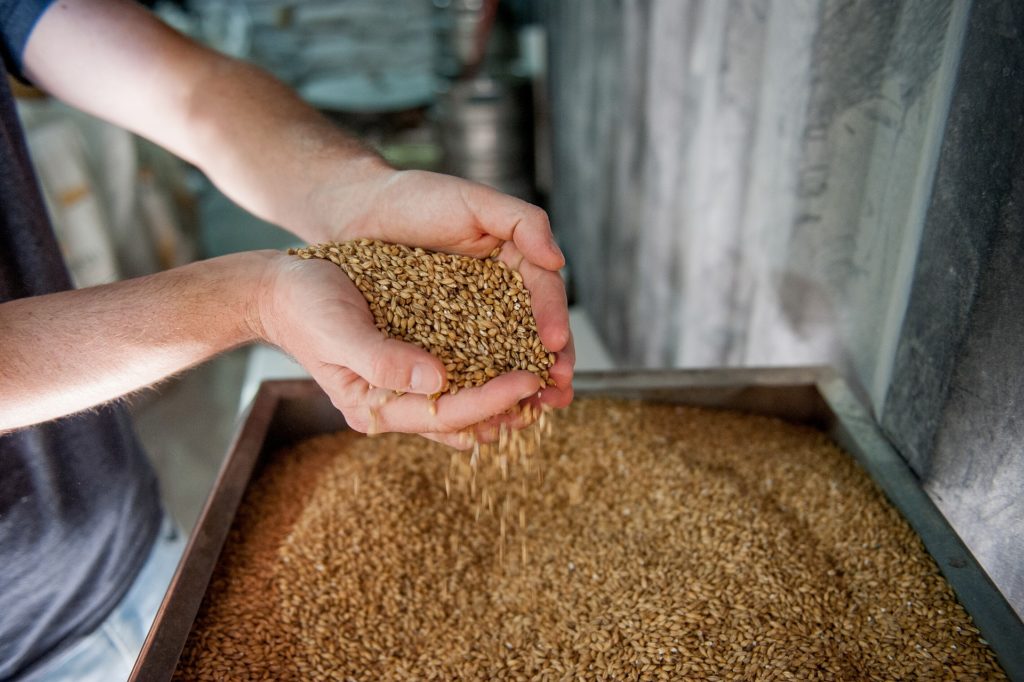Gose Beer – History, Style, And Recipes
Thursday, June 18th, 2020By: Ricardo J. Corbella – Brewmaster – Certified Beer Server Cicerone
Editor’s Note: This article was translated from Spanish. Every attempt was made to ensure proper meaning and grammar is true to the source.
Gose-style beer was first brewed more than a thousand years ago in a small town called Goslar in northern central Germany. That beer was probably significantly different from the Gose beer we drink today.
Gose, in German is pronounced “GO-zuh”, the name derives from the river that flows through Goslar, called Gose. As with most classic beer styles, it’s hard to know exactly when it originated, or what it looked and smelled like. This may be especially true for Gose, as it has a history that extends well in the past long before most beer styles.
The original Goslar beer, according to many sources, was fermented spontaneously or naturally, a culture that had established its residence in the wooden containers used to make and ferment beer. Overall, the process of elaboration before the 1400s was very different from today. The bubbling and boiling were usually not even part of the process. In some cases the brewers did not boil the must at all, and in others, they boiled the must, but not for long.
It could be assumed that Gose was initially prepared with grain or some kind of spice mixture and not with hops. It can also be concluded that these early Goslar beers would have been fermented by multiple types of organisms, probably several strains of Saccharomyces cerevisiae, as well as lactic acid bacteria, Brettanomyces, other wild yeasts and probably a little acetic acid bacteria if the beer was left to age.
Features of Gose Beer

It is a highly carbonated wheat beer, acidic, and fruity, with a restricted character of salt and coriander with low bitterness. They are very refreshing and feature vivid flavors and typically have high attenuation.
Many things play a role in the formation of the final taste of a beer. Specific processes, time, cleaning, equipment design, brewer skill, and ingredients can all drastically change the results. But none can be more important than good ingredients, particularly the water and yeast to be used.
Gose Ingredient Selection

Water: It is known from many sources that water from the Gose River was used to brew beers in Goslar. In the case of Gose beer, the mineral content of the water, especially its salinity, is a good part of what this beer is all about.
Malt: Most Gose brewers adhere to tradition, using a grain bill that consists of wheat and barley in equal proportions with wheat occasionally taking a slight advantage. The malt for Gose beer should be pale two row, pilsner malt, or other well modified pale barley.
Hops: Herbs provided the scent in the earliest Gose renditions. Over time these spices stopped being used and only hops and coriander remain. Its remarkable low bitterness is one of the things that defines its style, so hops are used in small quantities. Another reason is that Lactobacillus is not a hop-tolerant bacterium, only 5 IBUs can affect the growth of some lactobacillus bacteria, and without lactobacillus, the Gose would not be a sour beer. Hop additions would have been enough to prevent unwanted bacteria but low enough to allow lactobacillus to do its job. Traditionally hops would be a noble German variety, a clean hops of flavor, soft with low cohumulone content to impart a milder bitterness. Classic German varieties such as Hellertauer Mittelfruh, Saphir, Hersbrucker or Perle might be good options.
Yeast: A yeast with a relatively neutral flavor profile will allow the acidity of the beer to shine. Attenuation can be important in this style. A highly attenuated yeast will leave the beer dry and crispy, while a yeast with low attenuation will leave a beer with more sweetness. Alcohol tolerance is not a problem for Gose as it is a beer with a low to medium-low alcoholic content, and the same goes for flocculation, as it is not a clear beer.
Spontaneous fermentation: Gose beers were most likely fermented spontaneously. These beers began fermentation in 12 to 24 hours so there should be an immediate source of microganies to get the beer fermenting quickly. It has been suggested that wooden vessels, sometimes spruce, were a source of bacteria and yeast needed for fermentation. These containers may have acted as a home for resident microorganisms, brewers may have intentionally prevented deep washing of these, as they could have noticed that a more informal cleaning resulted in the next fermentation starting faster.
Fruits: Traditionally, fruit was not added to Gose, but as with Berliner weisse, flavored syrups were sometimes added to beer when served. Contemporary craft brewers have taken this concept and continue to add fruits, both natural and in syrup-form. The addition of fruits on the hot side has the obvious advantage in that they are sterilized by contact with the hot wort. The disadvantage is the loss of some subtle and more delicate flavors and aromas during boiling. Many fruits have seeds and if they are not removed before heating, they can be the cause of harsh and bitter flavors in beer. The fruit added on the warm side can also release pectin which will cause turbidity problems after fermentation. The addition of the fruit on the cold side can give the beer the closest flavors to the real fresh fruit. Like spices, the downside is that it has not been sterilized. Fresh fruit has a lot more bacteria than spices. To alleviate this problem many brewers use frozen fruit, as most bacteria cannot survive for long in freezing, but some bacteria can. Purees of pasteurized fruits are safer, which have then been frozen. The closer to the beginning of fermentation the fruit is added, the more flavor and aroma it loses from the decomposition it suffers during fermentation, the production and elimination of carbon dioxide, in particular, may be responsible for the loss of many aromatic compounds.
Salt: Legend has it that Gose’s salinity once came from the mineral-laden water of the Gose River. And unlike other regions of the world, salt was plentiful in the mountainous region of Harz around Goslar, therefore, salt was not a very expensive product.
Here’s the recipe of one of the great personalities of the brewing world:
Strong English Gose Recipe
“Gordon Strong,” BJCP Director USA
Original gravity: 1.042 (10.5oP)
Final gravity: 1,008 (2.1oF)
Bitternes: 9 IBU
Alcohol: 4.5% by volume
Apparent attenuation: 80%
Grain Bill
5.0 lb. (2.3 kg) German wheat malt
3.5 lb. (1.6 kg) Belgian Pilsner malt
Hops
0.7 oz. (20 g) Czech Saaz, 3% AA – first wort hop
Water
Reverse osmosis (RO) wáter 0.25 tsp. 10% phosphoric acid per 5 gallons (19 L) or until ph at room temperature.
1 tsp. (5 g) calcium chloride (CaCL2) to the mash
Yeast
Wyeast 1007 (German Ale) or White Labs WLP029 (German Ale/Kolsch) yeast.
*Two days before the day of preparation, make 1 qt. (1 L) yeast with the German strain ale, aerating the must thoroughly (preferably with oxygen) before releasing the yeast.
Additional Ingredients
0.26 az. (7.5 g) coriander seed, freshly ground 0 minutes.
0.35 oz. (10 g) kosher salt 0 minutes.
Souring Agent
19 capsules Swanson’s Probiotic Lactobacillus platarum Inner Bowel Support (10B cells/capsule)
Brewing Notes
Mash Target mash temp: 149o F (65oC)
Boil 10 min.
On the day of brewing, crush the malts to 149oF (65oC) into 13 gallon frames. (12 L) of water and keep this temperature for 60 minutes. Raise the temperature by infusion or direct heating to 168oF (76oC) for maceration. Recirculate for 20 minutes, spray with 168o F (76oC) of water until 6.5 gallons (25 L) of wort is collected. Lift the must until boiling and hold for 10 minutes. Do not add hops at this time. After boiling, I cooled to 95 degrees F (35 C). add the powder of 19 capsules of Swanson’s Probiotic L. Plantarum Inner Bowel Support (10B cells/capsule). Do not throw out the German ale yeast at this time. Purge the kettle with CO2 and cover. Hold for 12 or 24 hours at 95oF (35oC), or until the ph drops to 3.4. Add hops, boil the must for 90 minutes. Turn off the heat, then add the coriander into a mesh bag and salt. Steep for 5 minutes, then remove the bag. I cooled to 18oC placed the yeast initiator and fermented until complete. Once the fermentation is finished, ripen for a few days in cold, pass the beer to the barrel and force the carbonate to 3 volumes of CO 2.
Los Santos Hops – Gose Divino Recipe
Brewmasters: Ricardo Corbella, Juan Manuel Castagnini and Nicolas Piana.
Original gravity: 1,039 (10.5oP)
Final gravity: 1,008 (2.1oF)
Bitterness: 6 IBU
Alcohol: 4.2% by volume
Apparent attenuation: 80%
Grain Bill
12.12 lbs (5.5 kg) Malted Wheat
8.8 lbs (4 kg) Malta Pilsner
Hops
0.7 oz. (80 g) Czech Saaz, 3% AA first wort hop
Yeast
Yeast US-05, as it leaves us a neutral profile and works quite well despite the low ph of the must in fermentation.
Additional Ingredients
(0.8 g /L) fresh coriander and crushed 10 minutes before finishing the boil.
(10 g /L) himalayan salt 10 minutes before the boiling is over.
(3.5 L) pink grapefruit juice.
(8 kg) frozen pink grapefruit pulp.
Souring Agent
To acidify the wort we use 2 liters of liquid neutral yogurt containing L. acidophilus and possibly other strains of Lactobacillus.
BREWING NOTES
Mash at a temperature of 149oF (65oC) for 60 minutes.
We boiled for 10 min.
Prepare the pure and maintain this temperature for 60 minutes. Raise the temperature by mixing the infusion or heating to 76oC to finish mashing. Recirculate for 20 minutes, spray with water at 76oC of water until 58 or 60 L of wort is collected to bring to the boil. Heat the must until boiling for 10 minutes. Don’t add jumps at this time. After boiling, I cooled to 95 degrees F (35 C). At this time, add 2 liters of natural whole yogurt. Do not add US-05 yeast at this time. Purge the kettle with CO 2 and cover the pot. Hold for 12 or 24 hours at 95o F (35oC or 40oC), or until the ph drops to 3.4. Add hops in first wort, boil the must for 90 minutes. In the last 10 minutes of boiling add the cilantro and salt. Then transfer to fermenter cooling to 18oC, add the yeast and ferment until it is complete. Add the pink grapefruit juice and frozen fruit pulp. Allow to mature for a couple more days, transfer to a keg, force the carbonate to 3.2 volumes of CO 2.
Sources: Gose: Brewing a Classic German Beer for the Modern Era.
Fal Allen. September 7, 2018. Brewers Publications











One Response to “Gose Beer – History, Style, And Recipes”
Gose is a really nice beer. Had one in Hongkong with fermented salty Vietnamese lemons.
Thank was nice!
By Hans on Mar 28, 2023